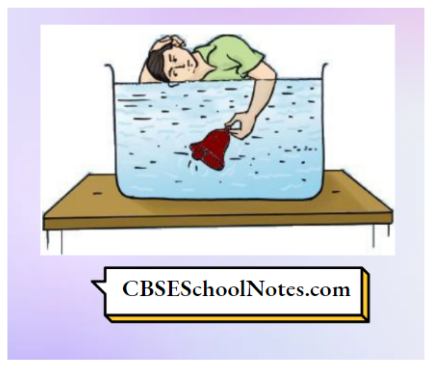Class 8 Science Chapter 11 Chemical Effects Of Electric Current Activity 1
Aim: To ensure that the tester is working properly.
Material Required: An Electric Bulb, a Battery, a metal water
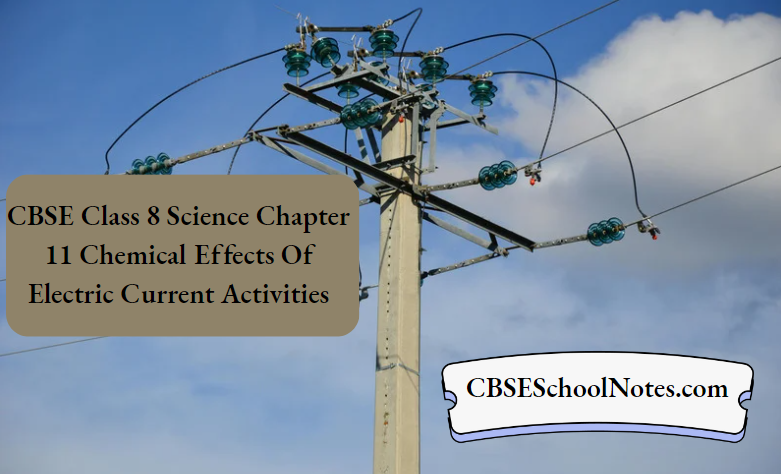
Procedure:
- Firstly, connect all the materials as shown in the figure to make a tester
- Join the free ends of the tester together for a moment. This completes the circuit of the tester and observe it.
- Now, if the bulb does not glow, it means that the tester
is not working. - The reason behind this may be that the connections are loose or the bulb is fused, or the battery is used up.
- Check whether all the connections are tight or not or replace the bulb and battery with another fresh bulb and battery.
- Now check if the tester is working or not.
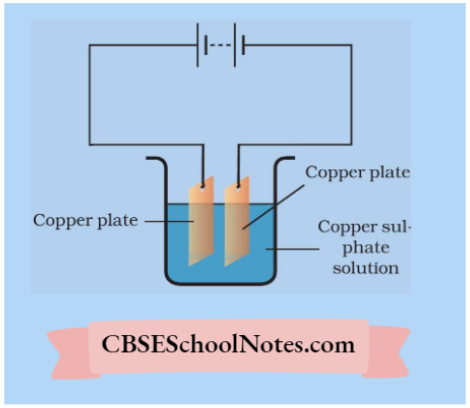
Conclusion: We have concluded that our tester is working. Now, we can use it to test the various liquids’ conductivity.
Read And Learn More CBSE Class 8 Science Activities
Class 8 Science Chapter 11 Chemical Effects Of Electric Current Activity 2
Aim: To test the conduction of electricity in lemon juice or vinegar.
Material Required: A tester, a few caps of plastic bottles, lemon juice or vinegar.
Procedure:
- Firstly, collect a few small plastic caps from discarded bottles and clean them.
- Now, put a teaspoon of lemon juice or vinegar in a plastic cap
- Bring the tester over this beaker and let the ends of the tester dip into the lemon Juice or vinegar.
- [Ensure that the ends should not be more than 1 cm apart
- Observe the bulb, you will find that the bulb glows very dimly.
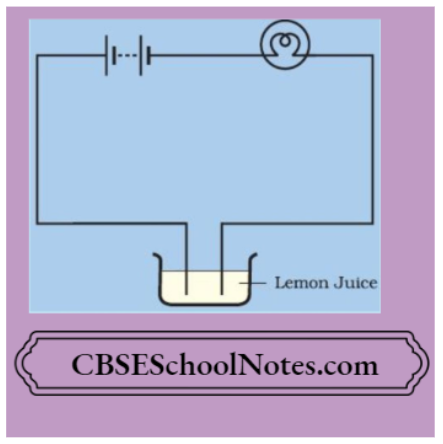
Conclusion: We have concluded that the liquid between the two ends of the tester allows the electric current to pass through it.
The dimly glowing bulb indicates that though vinegar or lemon juice conducts electricity but they are weak conductor of electricity.
Simple Electroplating Experiment For Class 8 With Copper Sulphate Solution Activity 3
Aim: To observe the conduction of electricity through different liquids by using another tester.
Material Required: A compass, different liquids like lemon juice, tap water, vegetable oil etc., an empty match box, two electric wires.
Procedure:
- Firstly, take a cardboard tray from the inside ofa discarded match box and place a small compass inside it.
- Now, wrap an electric wire around the cardboard tray and connect one free end to the terminal of a battery after leaving the other end free.
- Take another piece of wire and connect it to the other terminal of the battery. Your tester is ready to use.
- Now, repeat with the help of this tester. You will find a deflection in the compass needle when the free end of the tester is dipped in the lemon juice.
Repeat the Activity with other liquids such ns tap water, vegetable oil, milk, honey etc and observe the deflection. Remember to wash and wipe dry the ends of the tester afler testing each liquid.
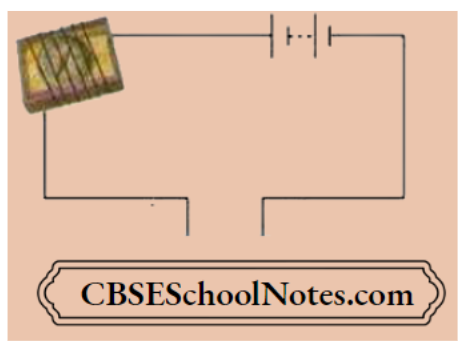
In each case, observe whether the magnetic needle shows deflection or not. Record your observations in the table below.
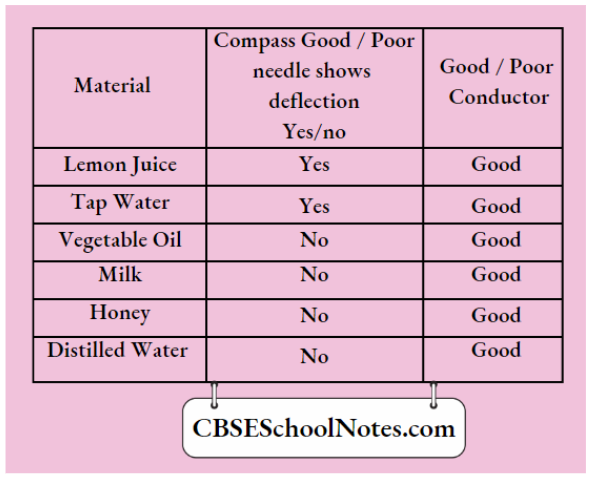
Conclusion: We have concluded that some liquids are good conductors of electricity, whereas other liquids are poor conductors of electricity.
Chemical Effects Of Electric Current: All Activities Activity 4
Aim: To show that a poor conductor can be a good conductor under some conditions.
Material Required: Distilled water, common salt, tester, plastic cap of a discarded bottle.
Procedure:
- Firstly, take some distilled water in a plastic cap.
- Now, use the tester to check whether distilled water conducts electricity or not. You will find that no electricity is conducted by the distilled water.
- Dissolve a pinch of common salt in distilled water and test the conductivity. You will find that electricity is conducting here.

Conclusion: We have concluded that, under some conditions poor conductor can become a good conductor of electricity.

Class 8 Science Chapter 11 Chemical Effects Of Electric Current Activity 5
Aim: To show that acid, base and salt solutions also conduct electricity.
Material Required: Three plastic caps of discarded bottles, distilled water, a tester, lemon juice, caustic soda, sugar.
Procedure
- Take three clean plastic caps of discarded bottles and pour about two teaspoons of distilled water in each of them.
- Add a few drops oflemon juice to distilled water in first cap. Similarly, add caustic soda and sugar to second and third cap, respectively.
- Now, test which solution conducts electricity and which does not.
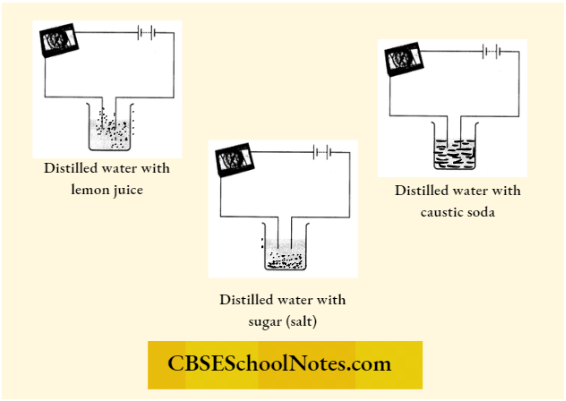
Conclusion: we have conclued that all the three solutions conduct electricity. It means that most of the liquids that conduct electricity are solutions of acids, bases and salts.
Class 8 Science Chapter 11 Chemical Effects Of Electric Current Activity 6
Aim: To demonstrate the chemical effects of electric current.
Material Required: A battery, copper wires, carbon rods, lemon juice, and water.
Procedure:
- Firstly, take out carbon rods from two discarded cells. Clean their metal caps with sandpaper.
- Now, wrap copper wires around the metal caps ofthe carbon rods and join them to a battery.
- Now, put a cup of water in a beaker. Also, add a few drops of lemon juice to the water to make it more conducting.
- Now, immerse the electrodes in this solution. Make sure that the metal caps of carbon rods are above the level of electrolyte in a beaker.
- Wait for 3 to 4 minutes. Notice the electrode carefully, we will see that the bubbles of gases are produced at the two carbon electrodes.
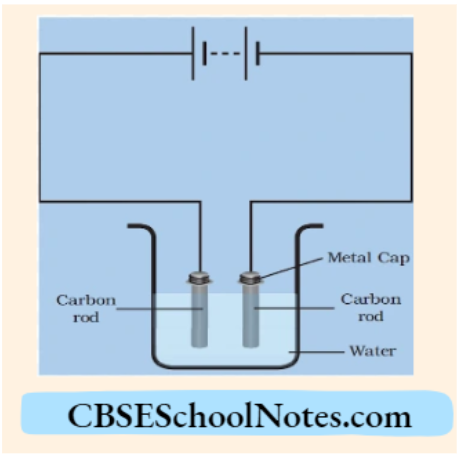
Conclusion: We have concluded that, the chemical reaction has taken place in the solution, when electric current is passing through it.
Class 8 Science Chapter 11 Chemical Effects Of Electric Current Activity 7
Aim: To electroplate a metal object with copper. Material Required Copper sulphate, 250 ml. distilled water. dry beaker, copper plates.
Procedure:
- Firstly, take copper sulphate and two copper plates of size around 10 cm x 4cm.
- Now, take 250 mL of distilled water in a clean and dry beaker and dissolve two teaspoons of copper sulphate in it and add a few drops of dilute sulphuric acid to this solution to make it more conducting.
- Now, clear the copper plates with sand paper and connect them to the terminals ofa battery and immerse them in copper sulphate solution.
- Allow the current to pass for about 15 min.
- Now, remove the electrodes from the solution and look at them carefully.
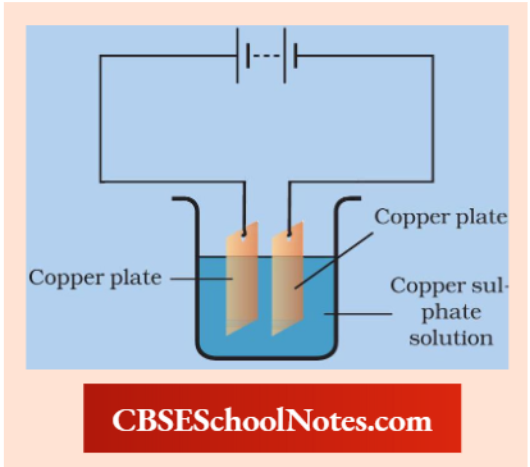
Conclusion: We have concluded that the copper metal gets transferred from the positive electrode to the negative electrode.























